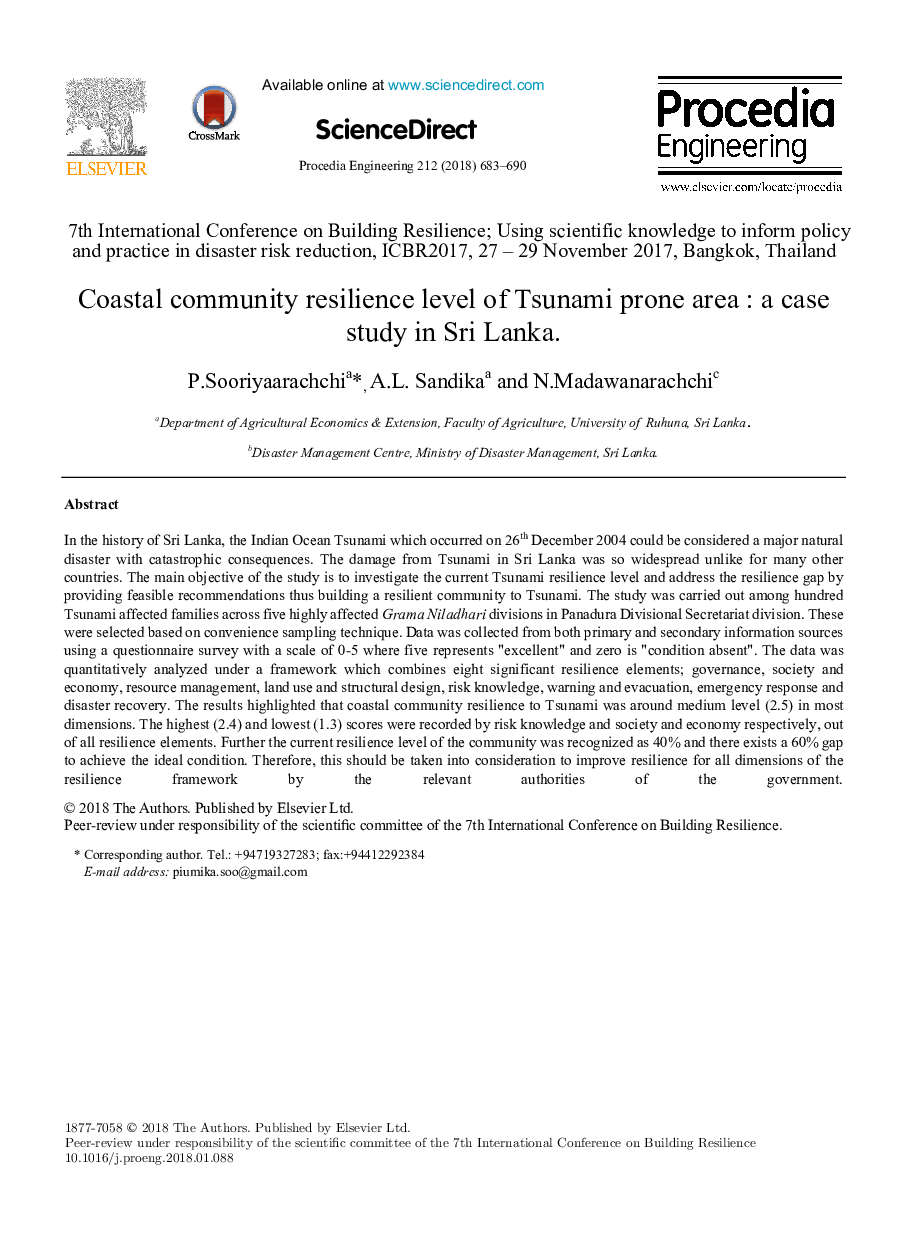| کد مقاله | کد نشریه | سال انتشار | مقاله انگلیسی | نسخه تمام متن |
|---|---|---|---|---|
| 7226122 | 1470611 | 2018 | 8 صفحه PDF | دانلود رایگان |
عنوان انگلیسی مقاله ISI
Coastal community resilience level of Tsunami prone area : a case study in Sri Lanka
ترجمه فارسی عنوان
سطح انعطاف پذیری ساحلی منطقه ناحیه سونامی: مطالعه موردی در سریلانکا
دانلود مقاله + سفارش ترجمه
دانلود مقاله ISI انگلیسی
رایگان برای ایرانیان
کلمات کلیدی
انعطاف پذیری، عناصر انعطاف پذیر، شکاف انعطاف پذیر، سونامی،
ترجمه چکیده
در تاریخ سریلانکا، سونامی اقیانوس هند که در تاریخ 26 دسامبر 2004 رخ داد، می تواند یک فاجعه طبیعی بزرگ با عواقب فاجعه بار باشد. خسارات ناشی از سونامی در سریلانکا بر خلاف بسیاری از کشورهای دیگر بسیار گسترده بود. هدف اصلی این مطالعه بررسی سطح انعطاف پذیری سونامی در حال حاضر و بررسی شکاف انعطاف پذیری با ارائه توصیه های امکان پذیر است بنابراین ایجاد جامعه انعطاف پذیر برای سونامی. این مطالعه در میان صد نفر از خانواده های مبتلا به سونامی در پنج بخش بسیار آسیب دیده گرما نیلاداری در بخش دبیرخانه بخش پانادورا انجام شد. اینها بر اساس روش نمونه گیری آسان انتخاب شدند. داده ها از منابع اطلاعاتی اولیه و ثانوی جمع آوری شده با استفاده از یک پرسشنامه با مقیاس 0-5 که در آن پنج نشان دهنده "عالی" و صفر "وضعیت وجود ندارد" جمع آوری شد. داده ها کمی بر اساس چارچوبی که هشت عنصر قابل انعطاف قابل توجه را تجزیه می کند تجزیه و تحلیل می شود. حکومت، جامعه و اقتصاد، مدیریت منابع، استفاده از زمین و طراحی ساختاری، دانش ریسک، هشدار و تخلیه، واکنش اضطراری و بازیابی فاجعه است. نتایج نشان داد که انعطاف پذیری جامعه ساحلی به سونامی در ابعاد متوسط (2.5) در بیشتر ابعاد است. بالاترین (2.4) و پایین ترین (1.3) نمره به دست آمده توسط دانش ریسک و جامعه و اقتصاد به ترتیب از تمامی عناصر مقاومتی ثبت شده است. علاوه بر این، میزان انعطاف پذیری فعلی جامعه به میزان 40 درصد به رسمیت شناخته شده است و فاصله ای 60 درصد برای دستیابی به شرایط ایده آل وجود دارد. بنابراین، باید این را در نظر گرفت تا به منظور ارتقاء قابلیت انعطاف پذیری برای تمام ابعاد چارچوب انعطاف پذیر توسط مقامات دولتی مورد توجه قرار گیرد.
موضوعات مرتبط
مهندسی و علوم پایه
سایر رشته های مهندسی
مهندسی (عمومی)
چکیده انگلیسی
In the history of Sri Lanka, the Indian Ocean Tsunami which occurred on 26th December 2004 could be considered a major natural disaster with catastrophic consequences. The damage from Tsunami in Sri Lanka was so widespread unlike for many other countries. The main objective of the study is to investigate the current Tsunami resilience level and address the resilience gap by providing feasible recommendations thus building a resilient community to Tsunami. The study was carried out among hundred Tsunami affected families across five highly affected Grama Niladhari divisions in Panadura Divisional Secretariat division. These were selected based on convenience sampling technique. Data was collected from both primary and secondary information sources using a questionnaire survey with a scale of 0-5 where five represents "excellent" and zero is "condition absent". The data was quantitatively analyzed under a framework which combines eight significant resilience elements; governance, society and economy, resource management, land use and structural design, risk knowledge, warning and evacuation, emergency response and disaster recovery. The results highlighted that coastal community resilience to Tsunami was around medium level (2.5) in most dimensions. The highest (2.4) and lowest (1.3) scores were recorded by risk knowledge and society and economy respectively, out of all resilience elements. Further the current resilience level of the community was recognized as 40% and there exists a 60% gap to achieve the ideal condition. Therefore, this should be taken into consideration to improve resilience for all dimensions of the resilience framework by the relevant authorities of the government.
ناشر
Database: Elsevier - ScienceDirect (ساینس دایرکت)
Journal: Procedia Engineering - Volume 212, 2018, Pages 683-690
Journal: Procedia Engineering - Volume 212, 2018, Pages 683-690
نویسندگان
P. Sooriyaarachchi, A.L. Sandika, N. Madawanarachchi,
